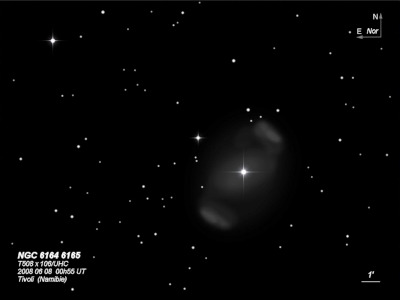
John Herschel discovered NGC 6164 = h3633 on 1 Jul 1834, along with NGC 6165, and recorded "Neb violently suspected immediately preceding a double star." His rough position (marked as approximate in RA and Dec (nearest arcmin)) is less than 2' south of the northwest wing of this large emission shell. NGC 6165 refers to the southeast wing.
Several older sources, including the RNGC, misclassify this object as a planetary nebula. The illuminating star is a massive, evolved O-star, losing mass from its outer layers through a strong stellar wind (similar mechanism to the Crescent Nebula = NGC 6188 and Thor's Helmet = NGC 2359).
400/500mm - 18" (7/8/02 - Magellan Observatory, Australia): this bipolar emission nebula was a startling sight at 171x and UHC filter! A bright illuminating star (HD 148937 at V = 6.8) is surrounded by two lobes or loops to the NW (NGC 6164) and SE (NGC 6165). Both loops contain brighter arcs symmetrically placed at the opposite ends. This is a large object, ~6' diameter, with the southeastern knot a bit brighter. A mag 9 star is 3' NE, outside the nebulosity. Located near the midpoint of mag 4.5 Epsilon Normae 1.3° NW and NGC 6188/6193 a similar distance SE.
600/800mm - 24" (4/11/08 - Magellan Observatory, Australia): this striking bi-polar nebula was quite impressive at 200x and UHC filter. The two bright loops or arcs are symmetrically placed along the rim, 2.6' NW and 3' SE of center with the southeastern arc brighter. The interior of the rim is filled with a fainter glow and the entire object forms a slightly elongated, 6.2'x5.2' oval. The nebula is dominated by the mag 6.8 central star (HD 148937). Mag 9 HD 148988 lies 3' NE of center.
Notes by Steve Gottlieb